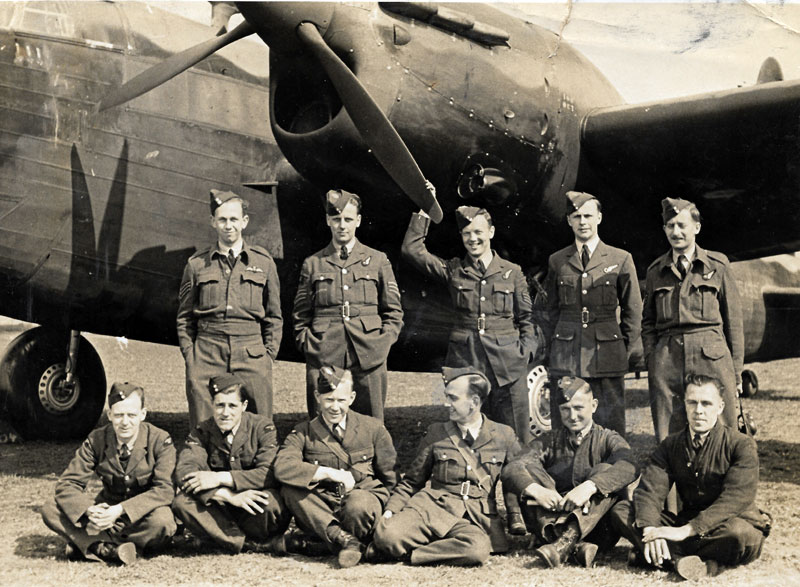Wellington W5531 damaged by enemy action, landed at Driffield airfield.
On the night of 14th / 15th July 1941 this 104 Squadron aircraft undertook an operational flight to bomb Hanover and took off from Driffield at 22.45hrs. The crew released their bombs over the target area from 7,500 feet. While roughly thirty miles away from Hamburg on the return the Wellington was attacked by a twin engined enemy aircraft, believed to have been a Heinkel HeIII by the crew. The enemy aircraft's fire caused damage to both turrets of the Wellington and also a wing was struck which caused the main undercarriage leg dropped down and a tyre being punctured. Despite the damage and holed fuel tanks in the damaged wing the crew were able to bring the aircraft back to the skies of Yorkshire. It was found that the damaged undercarriage leg would not lock into position so while the aircraft was still at 5,000 feet the captain ordered his crew to bale out. He then landed the aircraft at Driffield airfield at 05.35hrs. All airmen escaped injury. The landing was possibly a belly landing although the damage appears to have been repaired on site and generally a belly landing would create much more damage resulting in the aircraft being taken away for repairs. It could well be that the crew believed that the undercarriage had not locked down correctly as the electrical sensing equipment was damaged and would not give the green light in the cockpit but when the pilot attempted a landing it was actually locked down.
Pilot - P/O Robert Hubert McGlashan RAFVR (103491).
Second Pilot - Sgt David Gall Hodge RAFVR (1152494).
Observer - F/O Peter Bernard Verver RAFVR (43380).
Wireless Operator - Sgt Peter John Davey RAFVR (1163487).
Wireless Operator - Sgt Arthur Ernest Simpkin RAFVR (957726).
Air Gunner - Sgt Earle John Stevenson RCAF (R/59110).
This fantastic photograph shows Wellington W5435 and a number of the airmen listed above. This photograph shows Arthur Simpkin's crew in May and June 1941. Those who stood and are known are...Unknown, Simpkin, Unknown, Verver, Unknown.
I thank Arthur Simpkin's niece Wendy Magee for this photograph. Simpkins' regular crew in May 1941 was Cooke, Huggins, Verver, Haynes/Haines, Simpkin and Stevenson.
Peter verver service needs looking at in more detail. He was born in the Great Ouseburn district of what is now North Yorkshire in 1920. He was almost certainly serving in the RAF before WW2 and received a commission in the RAF around the start of the war but it gets slightly confusing as to what happened. He may have been serving in a ground trade as an officer but re-mustered as aircrew. He relinquished his commission on 15th July 1940 on appointment to a commission in the RAFVR but he had already been granted a short service commission in the RAFVR to the rank of Acting P/O on probation on 27th April 1940. He was then graded as P/O on probation on 5th January 1941 and may have risen to F/O six months later although I have not located his promotion in the London Gazette ( he was certainly serving as Acting F/O at the very least at the time of his death and this would be been made to a full F/O rank after his death). His brother Lt Cedrick Michael Verver R.A. died on 24th March 1945 and is buried in Wales.
Robert McGlashan received a commission to the rank of P/O on probation on 27th June 1941

On 3rd August 1941 McGlashan (aged 24), Verver (21), Simpkin (21), Hodge (20) and Stevenson (20) were flying an operational flight to Berlin with 104 Squadron in Wellington W5580 when the aircraft was ditched in the North Sea. Sadly died with the bodies of P/O McGlashan and Sgt Simpkin being found in the dinghy some days later (they were buried in Sylt) and later the body of F/O Verver was washed ashore and he too was buried in Sylt. F/O Verver, P/O McGlashan and Sgt Simpkin were later buried in Kiel War Cemetery. Twenty year olds Sgt David Hodge and Earle Stevenson were never found and are commemorated on the Runnymede Memorial.
Sgt Peter Davey was killed flying with 104 Squadron on 15th August 1941 when Wellington W5486 failed to return from an operational flight to Hannover. He is buried in Becklingen War Cemetery.
Wellington W5531 was built to contract B.71441/40 by Vickers Armstrong's Ltd. at Weybridge and was awaiting collection in May 1941. After a short period of MU storage it was taken on charge by 104 Squadron at Driffield. It sustained battle damage on 15th July 1941 but the incident is not recorded in its history. It must have been repaired on site and returned to 104 Squadron. It was then damaged again at Driffield on 9th September 1941 but this is also not recorded on its published Air Britain history, but it looks like both incidents resulted in minor damage (Possibly Cat.A(c)/FB). Again it was repaired on site and returned to 104 Squadron. On 14th February 1942 this was one of 104 Squadron 'C'Flight aircraft used when 158 Squadron formed at Driffield but shortly after it was transferred to 405 Squadron at Pocklington. On 13th April 1942 it suffered an engine fire on Ops to Essen and crashed near Stowmarket, Suffolk with two of the then crew being killed. Cat.E2/FB damage was recorded.